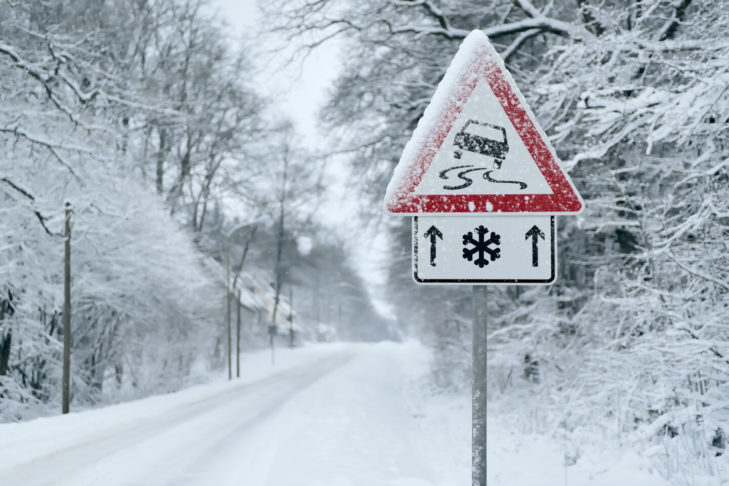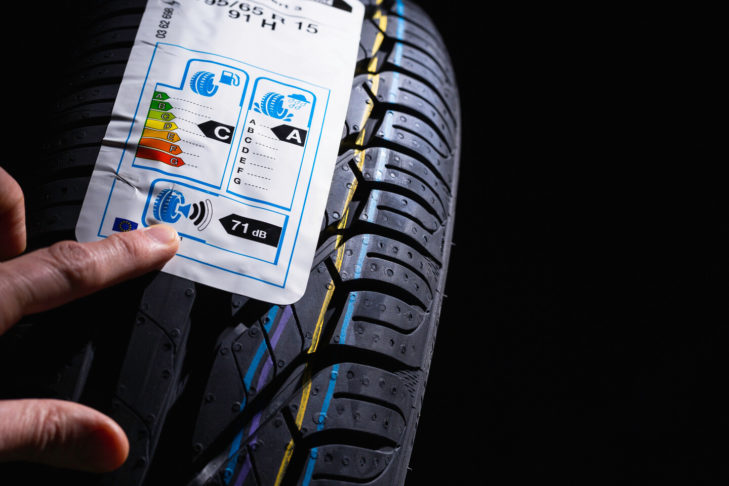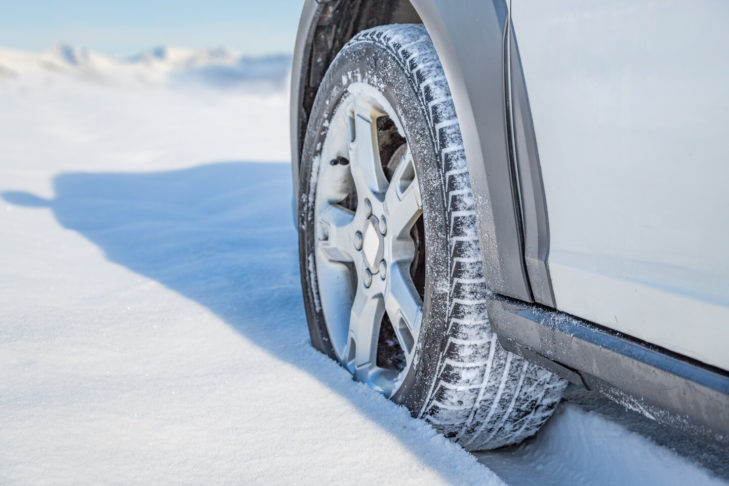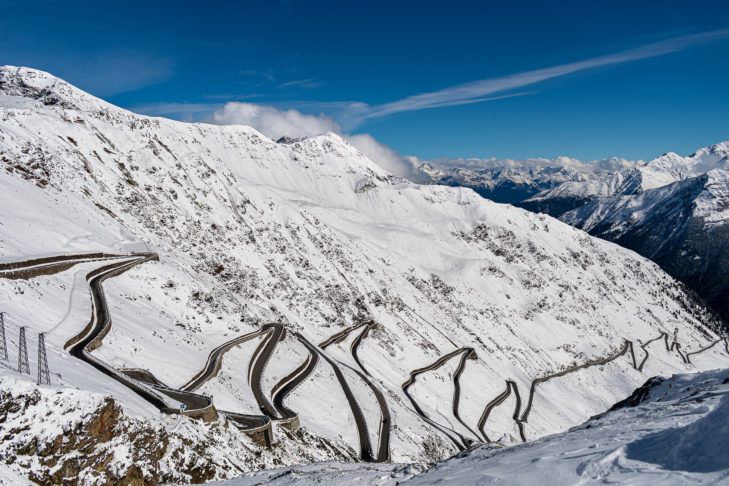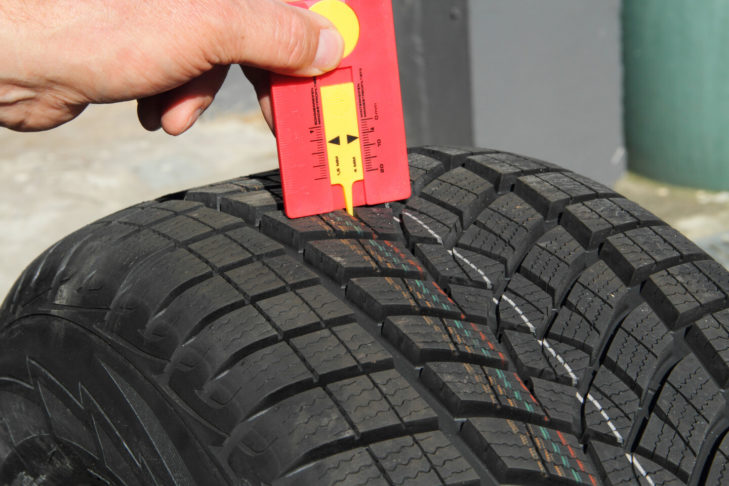Snow-covered forests and icy waters guarantee a real winter feeling in the cold season. However, these conditions also pose a challenge for many drivers, especially on the road. To master them, you need the right winter equipment for your own vehicle. And nothing is more important than good winter tyres. Having the right tyres on your car increases traction on snowy roads and therefore safety for all road users. SnowTrex explains what makes a suitable tyre for the cold season and how it can help make the journey to your favourite ski resort a relaxed one with a short winter tyre guide.
The right tyres put drivers ahead in winter
Low-profile summer tyres not only don’t help on snow-covered roads in the cold season, they are also a danger to other road users and are not even permitted under these conditions. At the end of the day, only the right tyres will get drivers ahead in winter. But how do winter sports enthusiasts who want to drive their own car into the mountains recognise the right winter tyres? The first thing to look out for when buying a new set of tyres is the EU tyre label. Since 2012, car tyres – similar to washing machines or fridges – must be labelled with this sticker by retailers. This allows tyre buyers to see the following information at first glance: Manufacturer, tyre type identifier, tyre size, load index, speed index and tyre class. The sticker also indicates how the tyres performed in a test procedure in three categories: Rolling resistance, wet braking properties and external road noise.
The rolling resistance of a tyre is ultimately also decisive for fuel consumption. All tyres approved in the EU are divided into classes A (dark green = very good) to E (red = poor). Experts estimate that there is a fuel-saving potential of 7.5 percent between class A and class G. For most cars sold in the EU, this means around 0.5 litres less per 100 kilometres. So with the right tyres, you can save money on every journey! One of many tips that drivers should bear in mind when it comes to winter tyres if they want to take their car on a ski holiday.
Just like the rolling resistance, the wet braking properties of a tyre are also divided into classes A to E. In this category, the grip of the tyres during emergency braking on wet roads is classified. And thus also directly the road safety of the respective tyres. Especially in winter, when the roads are often very wet, drivers should be aware that the braking distance differences between class A and E tyres are enormous. In some cases by up to 30 per cent. For a car travelling at 100 km/h, this means that the braking distance for an emergency stop on a wet road is almost 28 m longer. In concrete terms, this means that a car with class E winter tyres is still travelling at over 65 km/h, while the same vehicle with class A tyres is already stationary!
Lastly, the external driving noise is indicated on the label with a tyre pictogram and a loudspeaker symbol. The actual volume of the rolling noise is indicated behind this in decibels (dB). If the letter “A” is bolded under the loudspeaker, the tyre falls below the limit value by 3 dB or more. If the “B” is in bold, the noise level is within 3 dB under the limit value. No tyre is marked with a “C” because in this case it is louder than the EU limit value and would therefore not be eligible for approval. Incidentally, the noise limits are not the same for all wheels, regardless of whether they are summer or winter tyres. They depend on the classification, the tyre width and the type of tyre and therefore differ greatly in some cases.
Please also note that by using our services and integrating the YouTube API Services, the YouTube Terms of Service and the YouTube API Services Terms apply and your use of our website is deemed to be acceptance of these terms.
One car in the garage, so many winter tyres on offer
Drivers who are looking for new tyres for the cold season are now faced with a bit of a dilemma. Tyre and car parts dealers now offer a wide range of tyres for all seasons. And while the subject of summer tyres between May and September is pretty straightforward, the rest of the year is a different story. After all, it can start snowing as early as October or there can still be frost in April. Under these conditions, summer tyres are not permitted on the roads. Most drivers therefore traditionally opt for classic winter tyres at this time of year. But what about all-season tyres, also known as all-weather tyres, or M&S tyres?
First of all: winter tyres are still the first choice for ice and snow. However, this does not mean that all-season tyres are a mistake in winter. Demand for the all-rounder material has risen sharply among motorists in recent years. The proportion of cars sold with all-season tyres has reached 15 percent in some European countries. The clear advantage of all-season tyres is that they only need to be replaced when they are really worn. Otherwise, the tyres perform well both in high temperatures in summer and in frosty conditions in winter. Usually, drivers who are involved in an accident on snow and ice with all-weather tyres in winter need not worry that their insurance cover will lapse. Unlike with summer tyres, they are still protected against costs.
The prerequisite for this is that the all-season tyres not only have the familiar M+S symbol (mud and snow) on the tyre sidewall. The Alpine symbol (snowflake in a mountain) must also be stamped on the tyre. The latter in particular is absolutely crucial. Tyres that are only marked with M+S have no place in winter. Unless they were manufactured before 1 January 2018. In this case, the law (at least in Germany) allows them to be driven on snow until 30 September 2024. As an alternative to the annual change between summer and winter tyres, all-season tyres are primarily suitable for small car owners who live in a region where it rarely or never snows. If they only drive short distances and leave the car parked in winter in extreme weather, then they can safely use all-weather tyres from January to December.
With their distinctive tread, winter tyres still offer the best performance on the way to the ski resort. Their special tyre compounds make them frost-proof and the sipes in the tread ensure that they interlock perfectly even on slippery roads, providing maximum traction. In this type of weather in the high mountains, all-season tyres with their mixture of different properties remain just that: a compromise between summer and winter tyres.
How to drive safely and cheaply through the winter
Although manufacturers launch new winter tyres on the market every year with a major product offensive, they can easily be divided into three price segments: the premium tyre segment, the quality tyre segment and the budget tyre segment. The first segment is occupied by world-renowned tyre manufacturers such as Pirelli, Michelin and Bridgestone. Thanks to technical innovations, their products are always at the cutting edge. Of course, this also has an impact on the price of a new set of tyres, which starts at around 280 euros and is open at the top.
However, a high price is no guarantee of a genuine quality tyre. That’s exactly what you can still find in the next price segment. Best traction, with small differences in driving characteristics and material, at an acceptable cost. With these facts in mind, drivers can also choose winter tyres from Dunlop, Hankook or Uniroyal without any worries. They cost between 200 and 320 euros per set of four tyres. Products from manufacturers such as Petlas, Save or Superia are cheaper and therefore in the budget tyre segment. These tyres are usually manufactured in Asia. Inexpensive and good quality new tyres can also be found here, but drivers should seek advice from their specialist garage. You should budget between 160 and 280 euros for four new winter tyres.
What the rubber rollers from all three segments have in common, however, is the fact that these winter tyres should generally not be driven in summer. They are simply not designed for warm outside temperatures and hot, dry tarmac. In this weather, tests clearly show how dramatically the performance of winter tyres degrades here. On wet roads, the tyres still achieve acceptable results for the cold season. Under summer conditions, however, the braking distance of winter tyres at a speed of 100 km/h can increase by up to 16 metres. Due to the softer tyre compound designed for frost, winter tyres not only wear out more quickly in the heat, they also start to “smear” on the asphalt. This condition reduces grip at higher speeds, when fully loaded or on long bends. This is another reason why car experts strongly advise against driving on winter tyres in summer.
When should you drive with winter tyres?
There is no official deadline for when winter tyres should be fitted to your car. In Germany, people often talk about “O to O” (October to “Ostern”, i.e. Easter) when it comes to putting on the winter tyres. This “rule” is not carved in stone. However, in mountainous regions, winter temperatures and the first heavy snowfalls can occur as early as the beginning of autumn at the end of September. Therefore, there is generally nothing wrong with the rule of “O to O”, or “10-4”, or whichever mnemonic best suits you. Another guide to changing tyres is to look to neighbouring countries. Alpine countries such as Austria have introduced compulsory winter tyres for a certain period of the year. This usually applies from the beginning of November to mid-April and is also a good benchmark for visitors from abroad.
Other countries, other tyre rules
Winter tyre regulations in Germany
According to the German Road Traffic Regulations (StVO), winter tyres are mandatory in certain situations. This applies when temperatures are either so low that rainwater could freeze on the carriageway. Or if it is snowing continuously, so that a closed blanket of snow forms. Or when the white splendour thaws and a slippery slush forms on the asphalt. In these three cases, cars with summer tyres are no longer allowed on the roads. However, the situation is different if the sun is shining in December or January and the road surface is completely dry. Under these conditions, vehicles with tyres for the warm season are also allowed on the roads. Incidentally, the winter tyre requirement for trailers was completely abolished in Germany in 2010. However, in other European countries, especially in the Alps, the rules regarding winter tyres are very different.
Winter tyre regulations in Austria
In Austria, for example, winter tyres are compulsory in winter road conditions between 1 November and 15 April. During this period, they must be marked with an M+S symbol, which does not apply to all-season or all-weather tyres, although these are not generally prohibited in the Alpine republic. Anyone caught by the police with summer tyres on their car will have to dig deep into their own pockets. Because you could be fined up to 5,000 euros!
Winter tyre regulations in Switzerland
In Switzerland, which is normally known for its strict and above all expensive traffic regulations, winter tyres are not compulsory. If you are nevertheless driving on slippery roads with summer tyres and are involved in an accident, you will have to pay joint liability for “unsuitable tyres” and a fine of around 90 euros.
Winter tyre regulations in Italy
Further south in Italy, drivers should play it safe in the cold season and fit winter tyres. The reason: in Bella Italia, some regions have introduced compulsory winter tyres, while others have not. Sometimes the regulation is only temporarily indicated by signs. In South Tyrol, one of the most popular winter sports regions, however, winter tyres are compulsory from 15 November to 15 April. The local carabinieri can impose a fine of between 87 and 345 euros for offences.
Winter tyre regulations in France
Driving with summer tyres in winter is not quite as expensive in France. But there is another penalty here. Here too, winter tyres are only compulsory in the mountain regions of the Alps, the Pyrenees, the Vosges, the Jura and Massif Central as well as Corsica. However, this applies permanently between 1 November and 31 March and not depending on the weather situation. Drivers who are caught there by the gendarmerie without the appropriate tyres must pay a fine of 135 euros and leave their car parked. This means that French officials have the right to immobilise cars without winter tyres in the event of snowfall and frost!
Only a healthy winter tyre is a good winter tyre
In order to be able to offer optimum traction even in difficult road conditions during the cold season, it is particularly important to maintain winter tyres. In the event of recognisable defects, the tyres must be replaced immediately. It is always easy to tell whether a tyre is good for another season before the six-monthly tyre change. The tread depth of the tyre is absolutely crucial here. As a rule, manufacturers supply new winter tyres with a tread depth of 9 mm. In this condition, they offer optimum grip on ice and snow. In some countries, such as Germany, drivers are allowed to keep their tyres on until they reach a tread depth of 1.6 mm. If the rubber rollers are worn down to this mark, the tyres must be replaced.
Measuring the tread depth of winter tyres
Whether the value still complies with the German Road Traffic Regulations (StVO) can be easily determined with a folding rule or another measuring tape (the measuring point is always in the centre of the tread). If you don’t have this to hand, you can also use a 1-euro coin. The rule of thumb here is: if the golden edge protrudes from the rubber blocks, the tread depth is definitely less than 1.6 mm. Drivers who want maximum safety should consider buying new winter tyres from a tread depth of 4 mm. With the “old” material, traction will otherwise be critical on snow and slush.
Changing winter tyres
Drivers have two options when it comes to changing tyres. Firstly, they can carry out the procedure themselves using a jack and a torque spanner. For your own safety, it is important that the tyre change is carried out on a stable and, above all, level surface. Overall, however, changing tyres yourself is only recommended for car owners who are familiar with the tools and technology. If you are unsure about this or own an SUV whose tyres are particularly heavy due to their size, the second option is for you: a tyre change at a specialist garage. As a rule, car owners should expect to pay between 20 and 40 euros for changing a complete set of tyres.
Another service offered by most dealers is tyre balancing. The cost here is between 3 and 10 euros per wheel. They also offer adjustment of the electronic tyre pressure monitoring system, which all new cars have had to be equipped with since 2014. In addition, winter tyres can also be stored at the specialist garage in the same way as summer tyres if drivers do not have enough space for the tyres in their garage or basement. However, the costs can vary greatly from region to region. Drivers pay between 25 and 120 euros per season for storage plus tyre washing from various providers.
FAQ’s on winter tyres
Are winter tyres mandatory?
In Germany, winter tyres are not mandatory across the board, but are mandatory depending on the situation. In other words, drivers are not obliged to fit winter tyres to their vehicles during the cold season. However, if winter road conditions require appropriate tyres, cars with summer tyres must be left on the road. Section 2 of the German Road Traffic Regulations (StVO) stipulates that winter tyres must be fitted on roads with “black ice, slippery snow, slush, ice or frost”. If you are caught by the police with summer tyres on your car in these conditions, you will be fined 60 euros and given a point on your driving licence. Drivers who “obstruct other road users” with their choice of tyres will have to pay a fine of 80 euros and anyone who causes an accident will pay 120 euros.
How much do winter tyres cost?
The range of winter tyres is divided into three segments. A new set of winter tyres from manufacturers in the premium segment costs between 280 and 480 euros. Quality tyres from the mid-price range are between 200 and 320 euros per set. Drivers who want to save money when buying tyres, on the other hand, reach for the budget segment. Here, four new winter tyres cost between 160 and 280 euros.
What makes a good winter tyre?
Vehicle owners looking for a good winter tyre need to look out for a specific pictogram when buying. If the outer sidewall of the tyre is adorned with a snowflake framed by three mountain peaks, then this is the best choice. The “3PMSF” (3 Peak Mountain Snow Flake) symbol is now regarded as the unofficial standard for quickly identifying a good winter tyre. Tyres with this marking have been sent by the manufacturer to a certified laboratory for testing and therefore meet “a minimum level of safety and mobility performance on snow”.
How much does it cost to change winter tyres?
To achieve maximum safety, drivers should also have their tyres balanced at the same time when changing their winter tyres at a garage or trusted tyre dealer. Both combined cost between 10 and 20 euros. However, additional costs may be incurred if your vehicle is equipped with a tyre pressure monitoring system and the winter tyres have to be adjusted accordingly when changing.
Do I have to drive with winter tyres even if there is no snow?
If there is no snow in winter, there is no frost and the roads are dry, then drivers in Germany theoretically do not need to put on winter tyres – the same applies in Switzerland. However, as soon as it starts to snow or freeze, vehicles with summer tyres are no longer allowed to drive and must be abandoned by their owners. If the police catch a driver in Germany on snow-covered roads with summer tyres, a fine of at least 60 euros and a point in Flensburg will be imposed. In Alpine countries such as Austria, France and Italy, on the other hand, local or temporary winter tyre requirements must be observed.
What do drivers need to pay particular attention to when driving with winter tyres?
Unlike with summer tyres, drivers must pay attention to one important detail with winter tyres. This is that they must adhere to the permitted high speed of the tyres. This can be found on the tyre size code, which is stamped on the outer sidewall of the tyre. There is always a letter at the end which stands for the speed index. S means that the maximum permitted speed of the winter tyre is 180 km/h. T is 190 km/h, H is 210 km/h, V is 240 km/h and W is 270 km/h. The reason for the regulation is the fact that the tread of the winter tyre can detach from the carcass if the load is too high, which can lead to serious tyre damage at high speeds.
Can winter tyres also be used in summer?
Yes, unlike summer tyres, which can only be used in winter if the road conditions are absolutely dry, the law allows winter tyres to be used in summer, at least in Germany. Nevertheless, experts expressly advise drivers not to take this step. The softer tyre compound of winter tyres causes the handling of the car to deteriorate in warm to high temperatures. In addition, the wear on the tyres generally increases and fuel consumption rises. Most serious, however, is the fact that the braking distance of winter tyres increases significantly in summer. This means that drivers not only endanger themselves, but also other road users such as pedestrians and cyclists, especially in dangerous situations.
Are all-weather tyres just as good as winter tyres?
In deep winter road conditions, all-weather tyres, also known as all-season tyres, are not as good as winter tyres. Due to their tyre compound and structure, they combine the qualities of summer and winter tyres to a certain extent. They are somewhat softer and have a reinforced tread with the sipes typical of winter tyres. This means they offer drivers better traction in winter too. However, on icy roads or closed snow cover, all-weather tyres do not match the performance of winter tyres in terms of handling or braking distance.
When is an all-season tyre worthwhile?
Drivers who are either at home in the mountains or regularly go skiing in the mountains should deliberately avoid all-season tyres and instead opt for winter tyres during the cold season. However, all-season tyres are definitely an alternative to summer and winter tyres for some vehicle owners. For those who drive a small car and live in a region where it rarely or never snows. If you only drive short distances there and leave your car parked in extreme weather, you can safely use all-weather tyres from January to December.

